The machine learning (ML) engineering job market is projected to reach \$113.10 billion in 2025, with expectations to grow to \$503.40 billion by 2030, according to a Statista report.
The sector currently employs around 1.6 million people globally, with an increase of over 219,000 in the past year.
Clearly, as data creation and AI technology continue to grow, the demand for machine learning engineers shows no signs of slowing down.
So, how can you secure a stable career for the future? Simple: become a machine learning engineer.
This article is here to bring you insights into the 2025 machine learning engineer job outlook.
In our latest annual analysis of the machine learning engineer job market, we've examined over 1,000 job postings—bringing you current insights into what employers want from ML engineers in 2025.
Key Insights
- Depth Over Breadth: A majority (57.7%) of machine learning engineer job postings prefer Domain Experts over versatile generalists. Compared to data scientists, there’s a trend toward deep expertise in one or two core areas.
- Niche Algorithms Rarely Make the Cut: Despite the academic buzz, advanced ML methods like GANs, GNNs, and Bayesian approaches show up in less than 2% of job postings.
- Cloud Fluency is the New Default: Nearly 1 in 3 job listings mention AWS, cementing its dominance in ML infrastructure.
- PhDs Are the Norm—But Not the Rule: While 36.2% of roles require a PhD, a surprising 23.9% of listings don’t mention any degree at all. This suggests a growing trend: proof of skill trumps academic prestige, especially in smaller companies or startups.
- ML Pays—If you can prove you worth: The salary sweet spot lies between \$160K- \$200K, accounting for 1 in 3 job listings.
- The Experience Sweet Spot Is 2–6 Years: The most sought-after candidates fall into the 2–6 year experience range. Entry-level (0–2 years) and senior (8+ years) roles are far rarer.
Table of Contents
- Methodology
- What Does a Machine Learning Engineer Do? (Job Description & Specialization)
- How Can You Become a Machine Learning Engineer? (Education)
- What Technical Skills Do You Need as a Machine Learning Engineer? (Skills & Tools)
- How Can You Land a Machine Learning Engineer Job? (Locations & Salaries)
- What is the Machine Learning Engineer Job Outlook in 2025?
- Become a Machine Learning Engineer with 365 Data Science
- FAQs
Methodology
Based on our analysis of over 1,157 job listings from Glassdoor US, we've created a detailed snapshot of the machine learning engineer job market in 2025.
We processed the data by removing duplicate listings and analyzing key ML engineering keywords for requirements, skills, and trends from each posting.
To make the results more readable and comparable, we've converted our findings into percentages and created visualizations of the major trends.
What Does a Machine Learning Engineer Do?
Our job market analysis over the years has revealed an interesting shift in hiring patterns. Companies are shifting away from hiring specialists who focus on single data tasks—prioritizing professionals who can handle diverse responsibilities across the entire development pipeline.
We've created a custom metric—the Job Posting Specialization Score (JPSS)—to measure this trend. But first, let's explore what defines a modern ML engineer's role.
Machine Learning Engineer Job Description
Understanding machine learning engineer requirements is the first step for those interested in this field. Let's break down the machine learning engineer job description.
Machine learning engineers are technical experts who bridge theoretical ML concepts and practical implementation. They design, build, and deploy machine learning systems, optimize model performance, and create scalable ML infrastructure.
With increasing AI adoption across industries, companies need experts who can turn machine learning concepts into practical solutions. This has created a steady demand for ML engineers that we expect to continue through 2025.
Careers in machine learning typically require:
- Strong software engineering and ML system design expertise
- Proficiency in ML model deployment and optimization
- Experience with distributed computing and ML infrastructure
- Deep understanding of ML algorithms and mathematics
- Ability to collaborate with cross-functional teams
While data scientists focus on analyzing data and creating theoretical models through research and experiments, ML engineers are more hands-on, specializing in implementing and deploying these models at scale.
Job Posting Specialization Score (JPSS)
While this is the traditional description, what does the current machine learning engineer job market actually demand? To answer this question, we developed our innovative Job Posting Specialization Score (JPSS)!
The JPSS helps us understand whether companies are looking for specialists with deep expertise or generalists who can wear multiple hats.
Our research team examined job postings across 11 key competency areas. Each position was assigned an JPSS rating based on the breadth vs. depth of required expertise. Here’s our classification system:
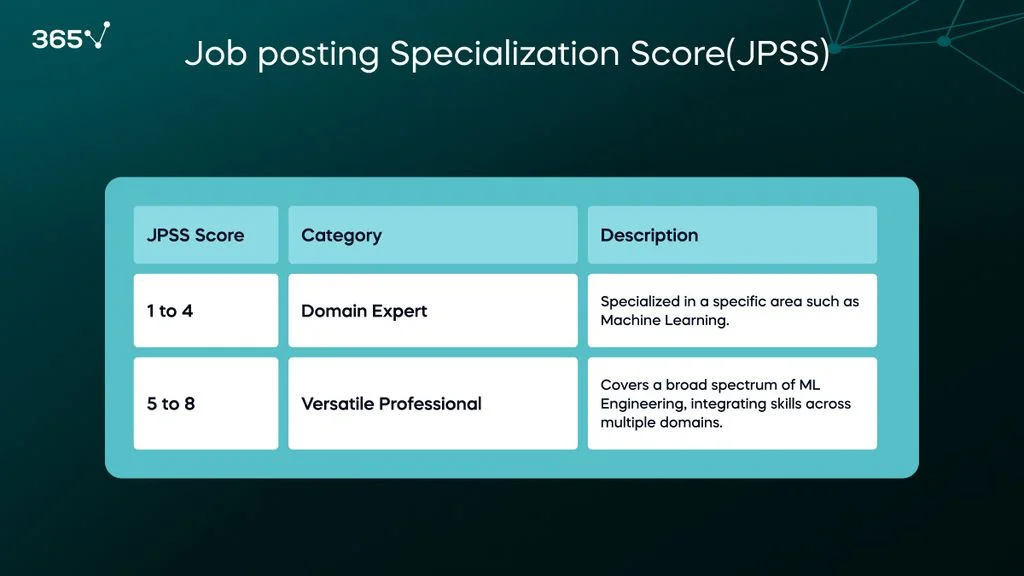
Here are the results:
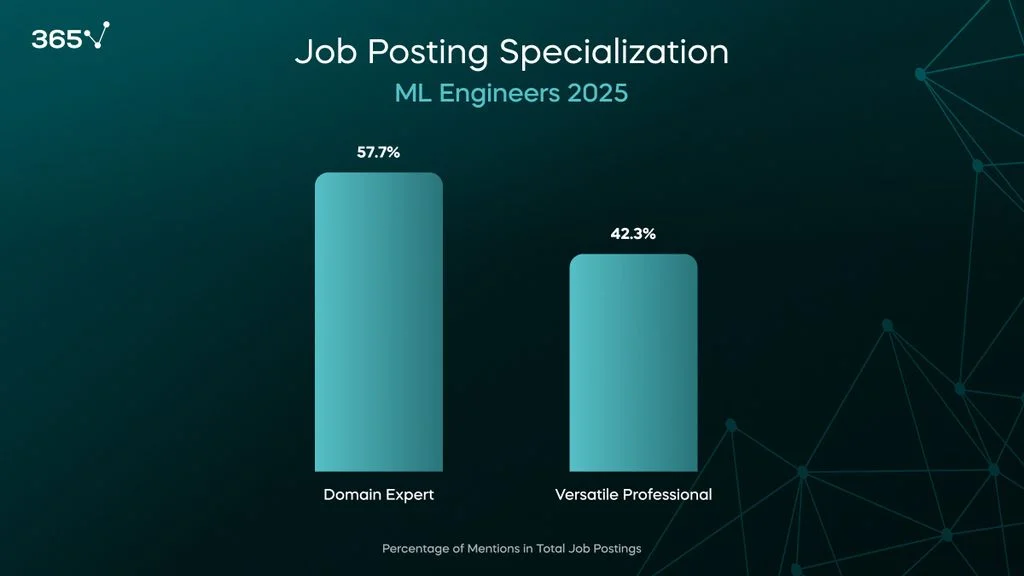
Among all our job market research for 2025, ML engineers showed the closest split between Domain Experts and Versatile Professionals—58% and 42%, respectively.
According to our findings, most employers prioritize candidates with in-depth machine learning engineer skills over those with broad knowledge of the entire data lifecycle. Nevertheless, 42% of job postings seek a broader knowledge base.
This balance reflects the maturing ML industry, where larger companies need specialized experts for developing cutting-edge algorithms, while smaller companies value versatile professionals who can integrate ML solutions into existing business systems.
Interestingly, data scientist was the only role where Versatile Professionals outnumbered Domain Experts in our 2025 research. In contrast, AI engineers and data analysts remain predominantly specialized roles.
This difference largely comes down to terminology. Employers define "Data scientist" in the broadest term, often encompassing various roles across the data pipeline—from data engineering to analysis and ML development. When they seek a data scientist, they're typically looking for a generalist rather than someone in a specialized data science role.
ML engineers, while sharing much of their expertise with traditional data scientists, are more specialized and don't carry the same "jack-of-all-trades" reputation that data scientists do.
Looking to build your ML engineer skills? 365 Data Science offers comprehensive courses from ML with Python to explorations into K-Nearest Neighbors, Random Forests, Support Vector Machines, and more—covering everything you need to master machine learning.
How Can You Become a Machine Learning Engineer?
Let's look at what education and qualifications employers seek in ML engineers. If you're wondering "How to become a machine learning engineer?," here's what you need to know.
Machine Learning Engineer Education Requirements
The traditional machine learning engineer education requirements typically include at least a bachelor’s degree, and often a master’s degree or a PhD.
Historically, AI and machine learning was primarily confined to academia. In the 80s and 90s, the field required extensive academic credentials and focused more on theoretical research and academic publications rather than practical applications.
In 2025, there are a number of non-academic careers in data and AI—including machine learning engineering.
The World Economic Forum's latest report indicates there are currently over half a million AI and ML engineering positions available worldwide, with most opportunities concentrated in the US, India, and Western European countries.
As a result, ML engineering is now more open to candidates who combine a strong academic background with hands-on skills. Let’s take a closer look at what kinds of machine learning degrees employers are looking for.
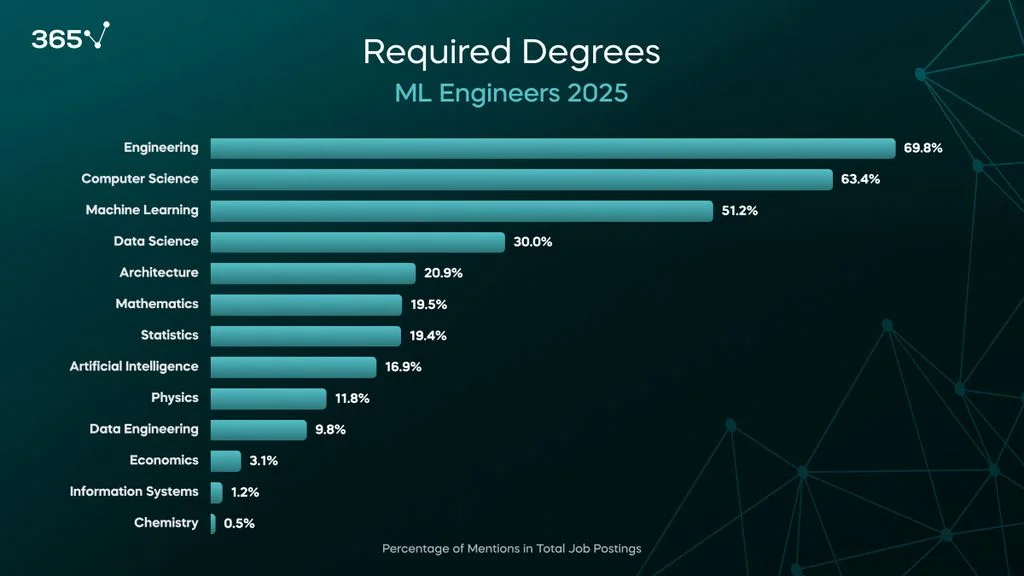
The most in-demand degrees are engineering, computer science, and machine learning, with each of these qualifications mentioned in more than 50% of job listings.
These figures have remained virtually unchanged from our 2024 ML engineer job market research, suggesting that educational requirements for machine learning engineers have stabilized as the industry matures.
This presents an interesting contrast with data scientists in 2025—our research for that role shows that the specialized "Data Science" degree has surpassed all others, jumping from 40% to 70% in the past year.
The "Machine Learning" degree, however, has maintained its third-place position at around 50% of machine learning engineers job postings. This trend suggests employers value the broader technical foundation that engineering or computer science degrees provide for ML implementation roles.
Now that we know which fields are most relevant, let's explore what level of education companies are looking for when hiring machine learning engineers in 2025.
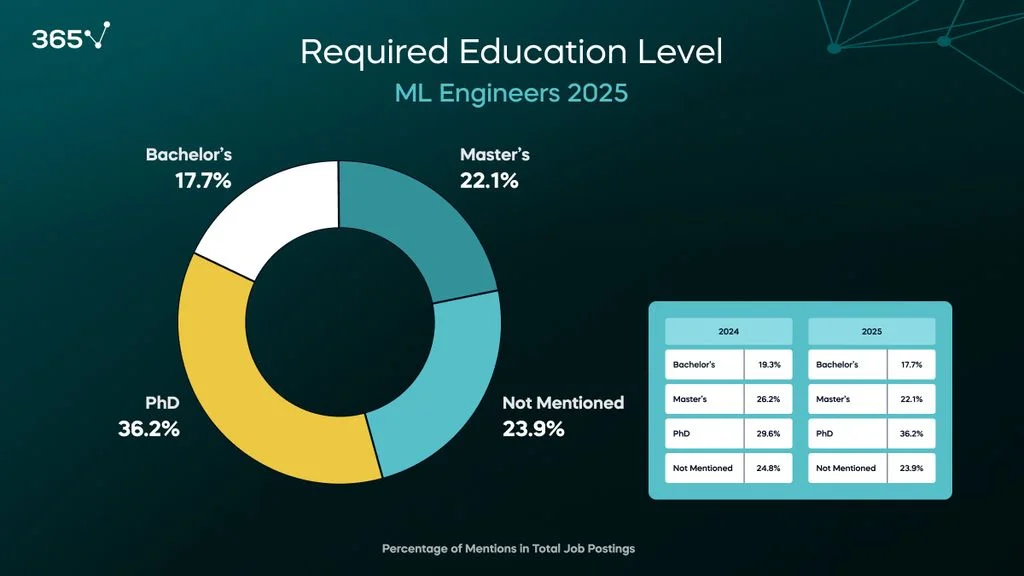
As we noted before, the machine learning career path has evolved from academia into a corporate profession—leading employers to become increasingly open to candidates without PhDs.
This trend is clearly reflected in our data. While PhDs still come out on top—required in 36% of job postings—22% of positions require a master's degree, and 18% accept candidates with a only bachelor's degree.
That being said, comparing these results with our 2024 research reveals some interesting trends.
|
2024 |
|
2025 |
|
|
Not Mentioned |
24.8% |
Not Mentioned |
23.9% |
|
Bachelor's |
19.3% |
Bachelor's |
17.7% |
|
Master's |
26.2% |
Master's |
22.1% |
|
PhD |
29.6% |
PhD |
36.2% |
As you can see in the table, the percentage of job postings mentioning PhDs jumped by over 6%, while the percentage requiring master's and bachelor's degrees decreased by around 5% and 2% respectively.
Here's what this means for you: If you're planning your machine learning job path, you should know that the field is getting more academically rigorous.
While you can still break into the industry with a bachelor's or master's degree, having a PhD is becoming more valuable. The industry seems to be putting more emphasis on deep theoretical knowledge—so if you're serious about a long-term career in ML engineering, considering a graduate program might give you an edge in the job market.
If traditional education isn't your path, don't worry—there are plenty of other ways to land jobs in machine learning.
Roughly 25% of job listings skip degree requirements entirely, indicating that they may care more about what you can do than what degree you have. We've seen, time and again, companies that focus on candidates who can prove their skills through hands-on experience and impressive project portfolios.
Professional certifications have become increasingly valuable too. Whether it's specialized tools, cloud platforms, or ML frameworks, having the right certifications shows employers you've mastered specific skills they need.
You can boost your bachelor's degree with professional certifications from our learning platform 365 Data Science—covering every essential topic needed to land a position in today's machine learning job market!
What Technical Skills Do You Need as a Machine Learning Engineer?
You can have all the fancy degrees in the world, but what really catches employers' attention is proven expertise. Let's look into the specific machine learning engineer skills that companies are actively seeking this year.
Programming Skills for Machine Learning
If you want to become a machine learning engineer, you'll need to start with solid programming skills. This is the backbone of everything ML engineers do—from writing efficient algorithms to getting models running smoothly in real-world applications.
Here’s what we saw in the job postings:
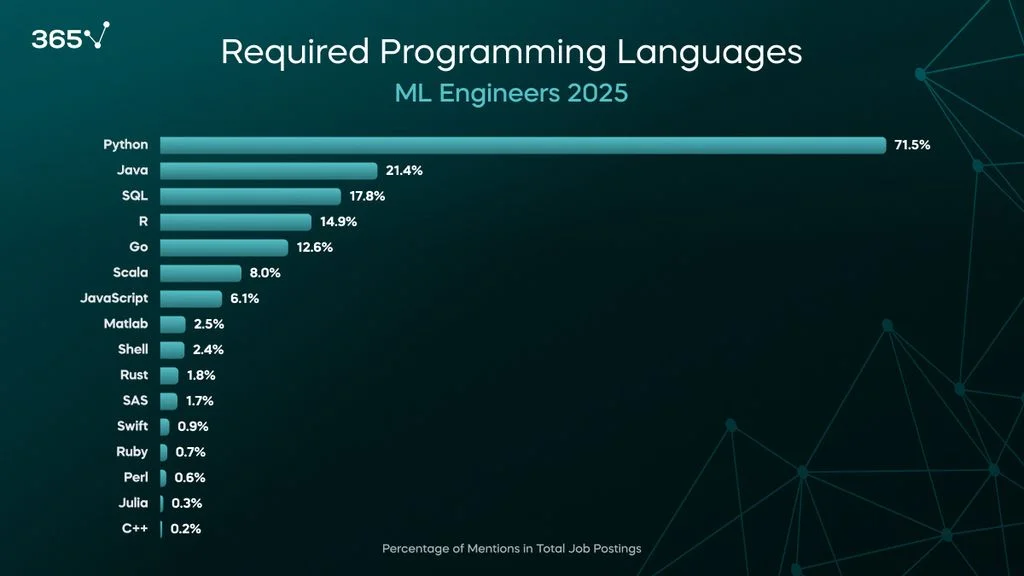
The top four languages remain the same since 2024, with Python in a dramatic lead at around 72% of job postings. Python has become the Swiss Army knife for ML engineers, handling everything from data wrangling to model deployment with a massive ecosystem of libraries and frameworks.
One interesting shift from 2024, however, is the importance of SQL. Last year, SQL was our most in-demand skill across all the roles we researched. It came in second place for ML engineers, at 26% of job postings.
In 2025, Java has surpassed SQL, appearing in 21% and 18% of job postings, respectively. These percentages mirror what we observed for AI engineer positions this year.
This shift in programming language requirements suggests that ML engineering roles are becoming more focused on production-level implementation and deployment. The rise of Java over SQL indicates employers are placing greater emphasis on building and maintaining production ML systems rather than just data manipulation and querying.
Want to master Python, the most popular programming language? Our Python Programming Bootcamp offers 20 hours of hands-on lessons, giving you everything you need to kickstart your machine learning career.
Machine Learning Skills & Tools
On top of programming, the most important skills for machine learning engineers are—clearly—machine learning skills. Here’s what the machine learning engineer job outlook for 2025 says.
Machine Learning Skills
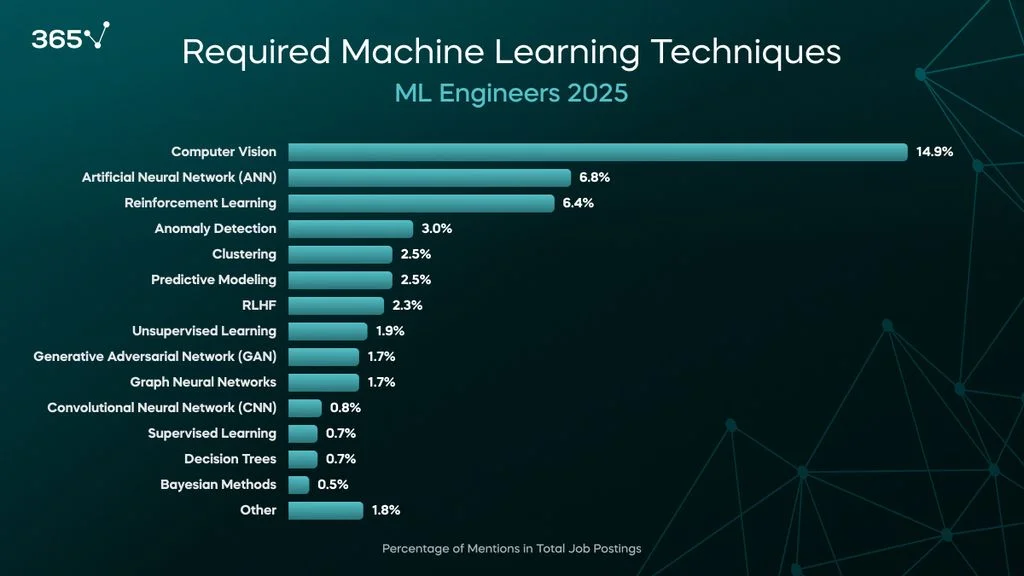
|
Technique |
% of Job Postings |
Insights |
|
Computer Vision |
14.9% |
Extremely in-demand due to applications in self-driving cars, facial recognition, medical imaging, manufacturing, and so much more. |
|
Artificial Neural Networks (ANN) |
6.8% |
Core to deep learning models; widely used in image, speech, and text processing. |
|
Reinforcement Learning |
6.4% |
Popular in robotics, game AI, and finance; driven by real-time decision-making needs. |
|
Anomaly Detection |
3.0% |
Key for fraud detection, cybersecurity, and system monitoring. |
|
Clustering |
2.5% |
Common in customer segmentation and unsupervised pattern discovery. |
|
Predictive Modeling |
2.5% |
Broad use across industries—forecasting, risk scoring, and business intelligence. |
|
RLHF (Reinforcement Learning with Human Feedback) |
2.3% |
Rising due to the influence of large language models and alignment techniques. |
Keep in mind that these percentages can be a bit misleading. Most employers expect ML candidates to have these foundational skills—it's considered standard knowledge for the field. When companies specifically mention certain skills in their job posts, it's usually because they want to emphasize their particular importance for that role.
So, keep an eye out for the top skills mentioned here, because they’re particularly in-demand this year.
Machine Learning Tools
To apply these skills effectively, you'll need to master specific machine learning tools.
Here are the most in-demand tools in the machine learning engineer job market for 2025.
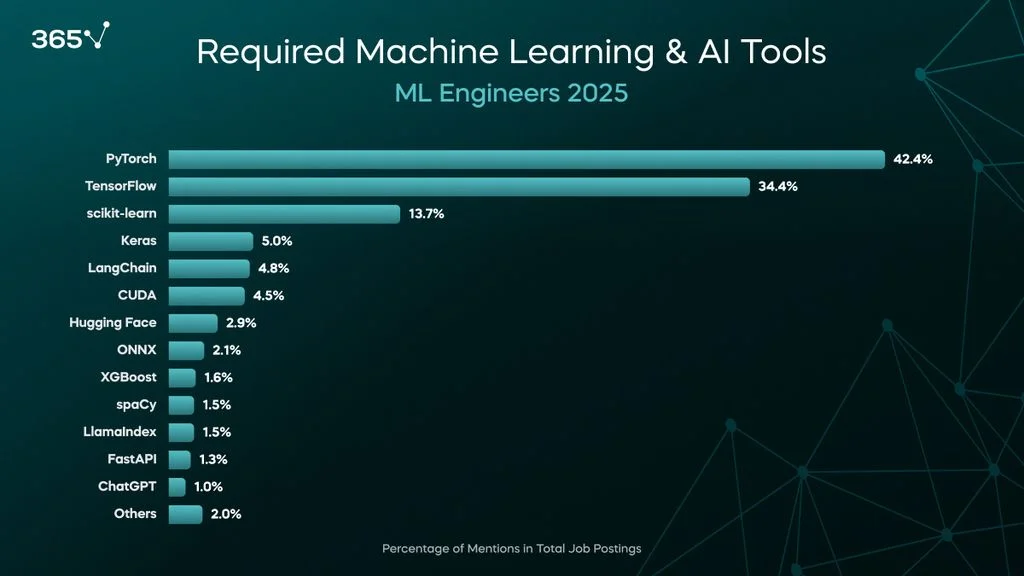
PyTorch leads the pack—mentioned in 42% of machine learning engineer job postings—thanks to its flexibility, dynamic computation graphs, and strong support from both academia and industry. It's especially popular for deep learning tasks like computer vision and NLP, and is now the preferred framework for building and fine-tuning large language models.
TensorFlow—noted in 34% of postings—is widely used in enterprise ML environments due to its robust production tools and strong deployment ecosystem. It remains popular in the 2025 machine learning job outlook for building scalable AI systems across industries like healthcare and finance.
scikit-learn—mentioned in 14% of postings—is a staple for classical machine learning. It’s simple and versatile in prototyping, feature engineering, and traditional models. It continues to be an essential tool for foundational ML work where deep learning isn't necessary.
These results haven't changed significantly since our 2024 research, suggesting these tools are here to stay—so you should make sure they're in your toolkit.
Want to learn these tools quickly? 365 Data Science’s courses cover ChatGPT, Python frameworks like TensorFlow, modern tools like LangChain, plus so much more. Start learning today!
MLOps & Developments Methodologies
MLOps is how machine learning models get built, tested, and put into real-world use.
It helps ML engineers keep models running smoothly, update them when needed, and make sure they work well at scale—a highly important ML engineer skill in 2025.
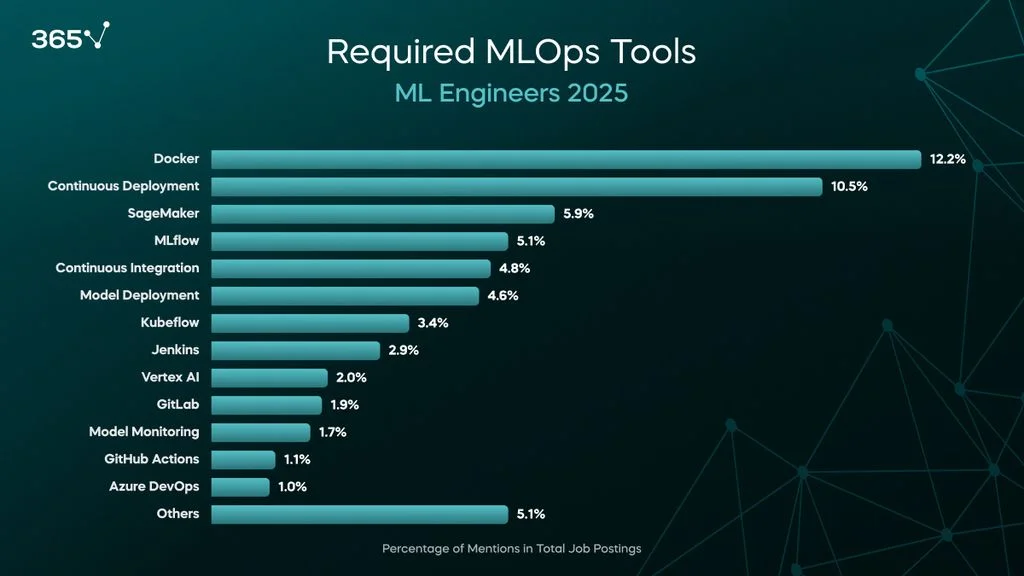
For machine learning engineers, MLOps means working with tools like Docker, Kubernetes, MLflow, and CI/CD pipelines. Let’s take a closer look at how they appear in the 2025 machine learning engineer job outlook.
|
Tool |
% of Job Postings |
Insights |
|
Docker |
12.2% |
Used to containerize ML applications, ensuring consistency across environments. |
|
Continuous Deployment (CD) |
10.5% |
Automates the release of ML models to production, enabling faster updates. |
|
SageMaker |
5.9% |
AWS platform for building, training, and deploying ML models at scale. |
|
MLflow |
5.1% |
Manages ML experiments, model tracking, and deployment workflows. |
Development methodologies are the practical ways teams work together to create and launch ML systems. They help teams stay organized, work efficiently together, and track their progress from start to finish.
Here are some of the popular tools employers expect ML engineers to work with in 2025:
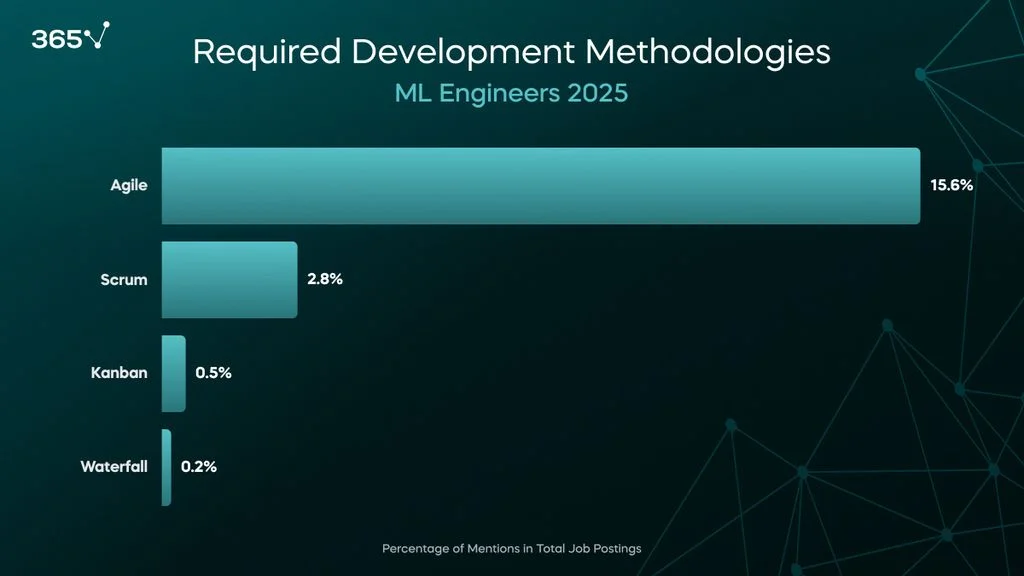 The most popular development methodology is Agile, mentioned in 16% of machine learning engineer job postings. Teams work in short cycles, called sprints, to deliver updates quickly and adapt to feedback in real-time.
The most popular development methodology is Agile, mentioned in 16% of machine learning engineer job postings. Teams work in short cycles, called sprints, to deliver updates quickly and adapt to feedback in real-time.
Scrum is also popular, noted in 3% of postings. Scrum breaks work into sprints with clear roles, daily check-ins, and regular reviews. Teams across software and ML commonly use it.
Looking to master Agile and Scrum? Our Agile and Scrum Project Management course teaches you how to develop tech and software projects from start to finish. Check it out now!
AI Skills
Machine learning careers now extend beyond traditional modeling to include building and integrating cutting-edge AI systems.
Companies want engineers who can work with everything from large language models to chatbots and recommendation engines.
How do AI skills factor into ML engineering roles in 2025? Let's explore.
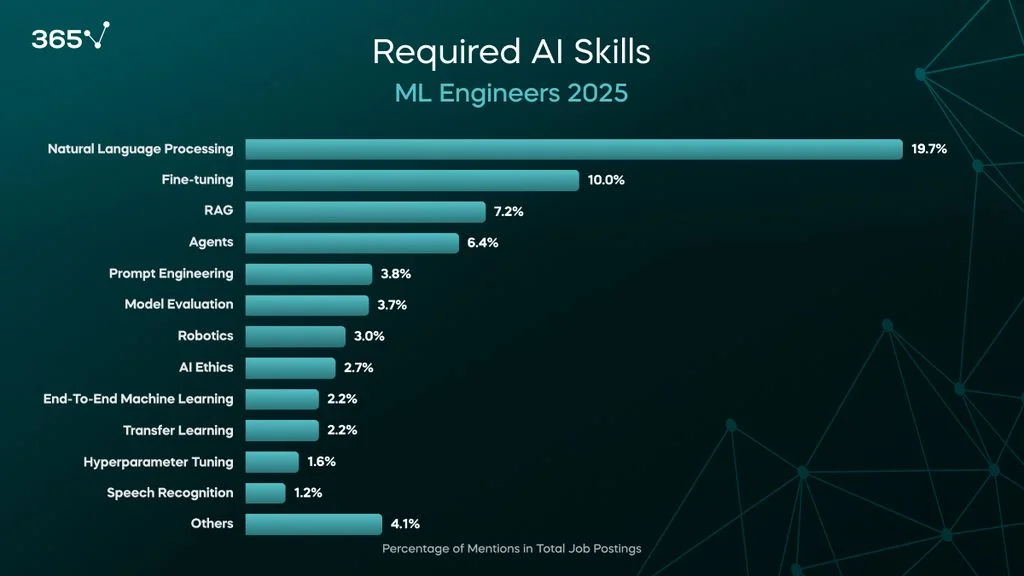
|
AI Skill |
% of Job Postings |
Insights |
|
Natural Language Processing (NLP) |
19.7% |
NLP leads the list as demand surges for chatbots, language models, and text analysis tools across industries. |
|
Fine-tuning |
10.0% |
As pre-trained models become the norm, fine-tuning is key for customizing them to company-specific tasks. |
|
Retrieval-Augmented Generation (RAG) |
7.2% |
RAG is gaining traction for combining large language models with search to improve accuracy and context. |
|
Agents |
6.4% |
AI agents are rising in popularity for their ability to handle multi-step reasoning, task automation, and dynamic workflows. |
Cloud Skills for ML Engineers
Cloud skills have become a must-have machine learning engineer skill as more companies move their data and workflows to popular cloud platforms. They let teams build, train, and deploy models faster, without worrying about setting up their own servers.
Every year, we find higher mentions of cloud skills in our job market research—and ML engineers are no exception.
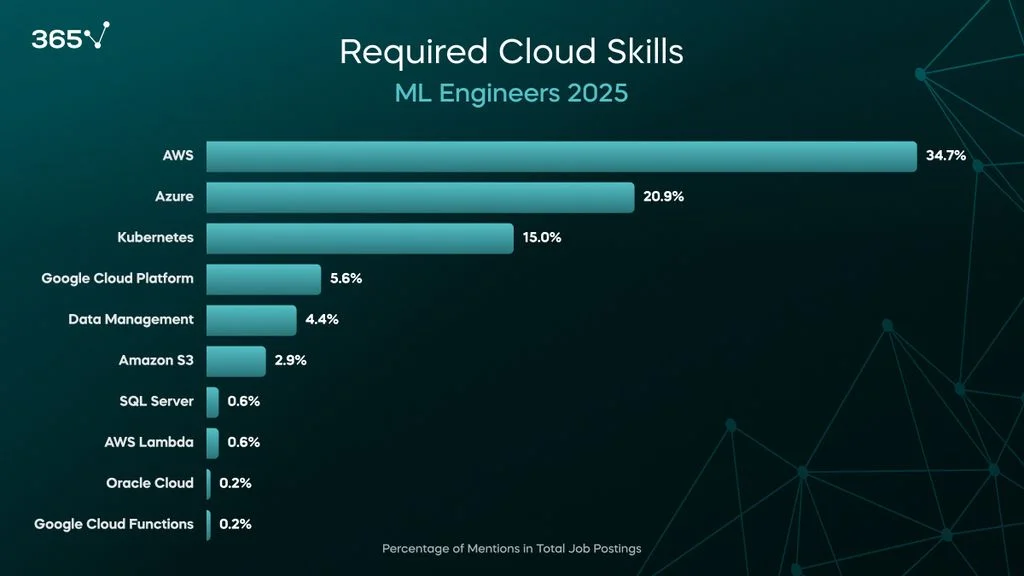
As you might expect if you have worked in the cloud before, Amazon Web Services (AWS) and Microsoft Azure are in the lead—mentioned in 35% and 21% of postings respectively.
AWS and Azure are popular because they’ve been around the longest and offer the most complete set of tools. AWS dominates in scale and flexibility, while Azure is strong with businesses already using Microsoft tools like Office and Teams.
Cloud platform mentions have increased overall since 2024, with an interesting shift in popularity. While Azure previously held a slight lead over AWS (18% vs 16%), in 2025 AWS has started to dominate—surpassing Azure by about 14%.
This trend was consistent across all data and AI roles we researched in 2025. So, if you're looking to start with cloud platforms, AWS is likely your best choice.
New to cloud computing? Our latest course, Understanding Cloud Computing, provides a comprehensive overview of cloud concepts, covering industry fundamentals, key characteristics, and professional roles within the field. Start learning essential ML engineer skills today!
Interdisciplinary Technical Skills
According to our latest analysis of machine learning engineer job requirements in 2025, these positions need an increasingly diverse skill set. In fact, 42% of job postings seek candidates who can handle multiple aspects of the ML lifecycle beyond core machine learning engineer skills.
SQL proficiency has become important for ML engineers. Many organizations need professionals who can handle both modeling and data pipeline work.
Data Engineering Skills for ML Engineers
Let’s take a closer look at how this manifests in the 2025 machine learning engineer job outlook.
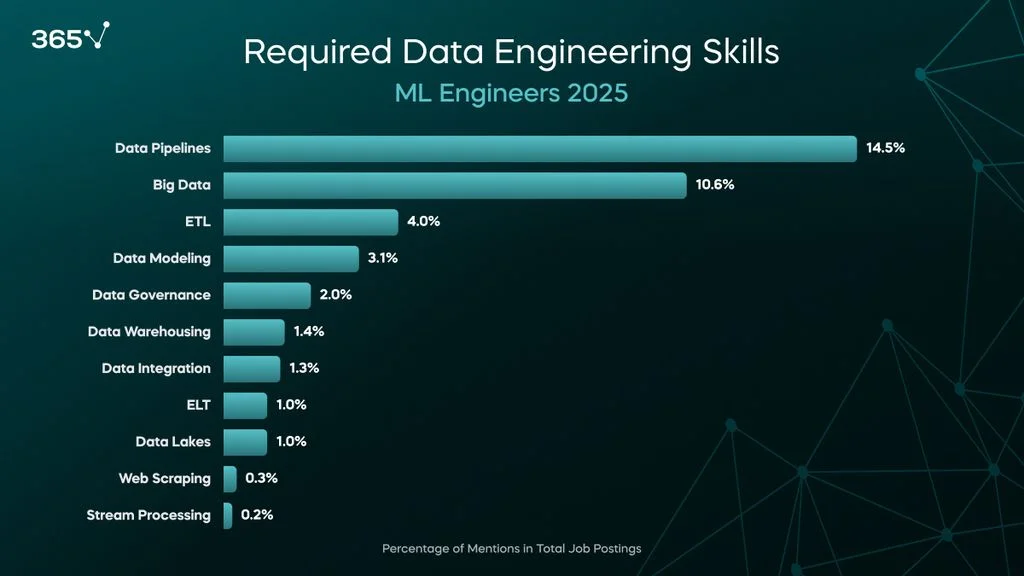
|
Skill |
% of Job Postings |
Insights |
|
Data Pipelines |
14.5% |
Essential for moving data from raw sources to models—ML engineers often build and maintain these to keep workflows running smoothly. |
|
Big Data |
10.6% |
Many ML systems work with massive datasets, so ML engineers need to know how to handle scale using tools like Spark or Hadoop. |
|
ETL (Extract, Transform, Load) |
4.0% |
ETL processes are key for cleaning and prepping data before training, making them a core skill for end-to-end model development. |
Master data pipelines and warehousing with our comprehensive courses! Learn to build and maintain the ETL processes and data infrastructure that power modern ML systems. Start learning today!
Data Engineering Tools for ML Engineers
To round out your skill set, here are the key data engineering tools you'll need to master in today's machine learning engineer job market.
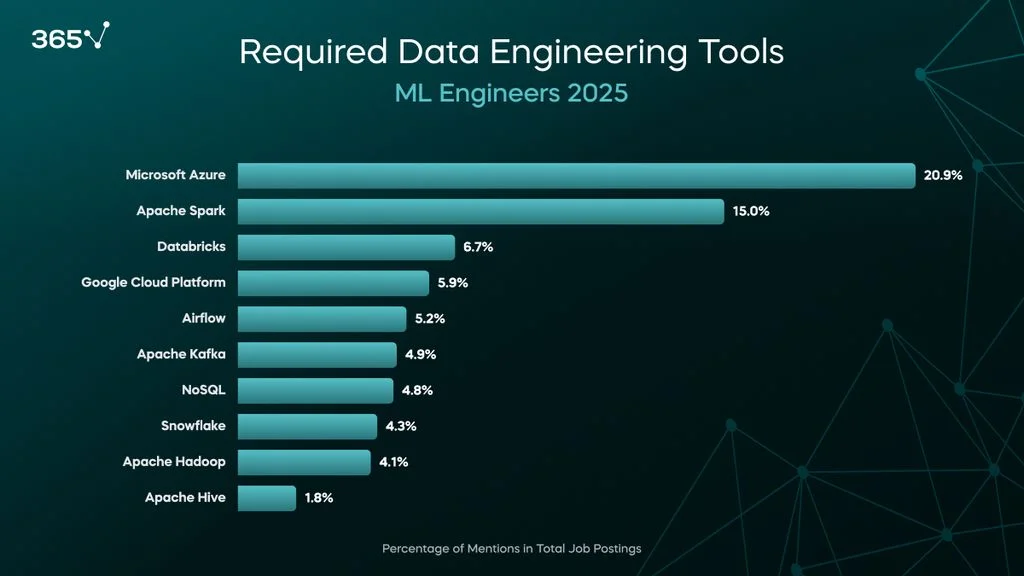
We’ve already discussed Azure and other cloud platforms above, so let’s focus on the more core data engineering tools.
|
Tool |
% of Job Postings |
Insights |
|
Apache Spark |
15.0% |
Great for handling large-scale data processing and analytics. Its speed and scalability make it a top choice for big data pipelines. |
|
Databricks |
6.7% |
Built on Spark, it’s popular for collaborative ML workflows and unifying data teams on a single platform. |
|
Airflow |
5.2% |
A go-to tool for scheduling and managing data pipelines. ML engineers rely on it for automating complex workflows across systems. |
Want to master data pipeline orchestration? Our comprehensive Apache Airflow course teaches you to build scalable workflows across AWS, Azure, and GCP. Start learning now!
How Can You Land a Machine Learning Engineer Job?
Next in our machine learning engineer job outlook, we'll look at two key factors to consider when choosing machine learning careers: locations and salaries.
Where Do Machine Learning Engineers Work?
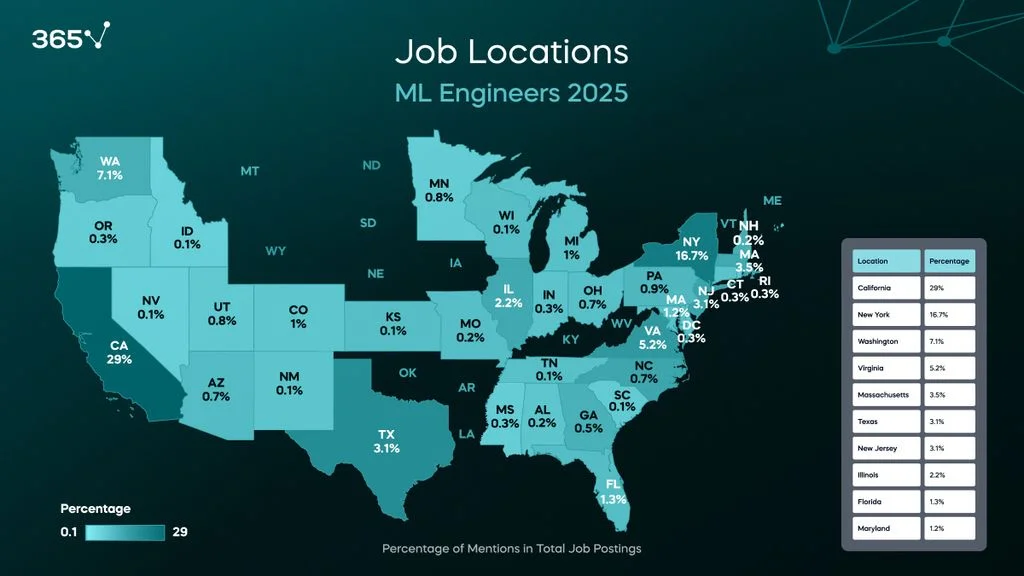
When it comes to ML engineering jobs in 2025, California remains the undisputed leader. With 29% of all job postings, the state continues to be the epicenter of machine learning innovation and development.
What's catching our attention though is New York's growing presence, now holding 17% of ML engineering positions. This shift reflects a broader trend where machine learning talent is becoming more distributed across the country—New York actually surpassed California for data scientists and analysts this year!
California's dominance stems from its concentration of tech giants, innovative startups, leading research institutions, as well as the abundant venture capital.
The remaining spots in the top 10 states for ML jobs include Washington, Virginia, Massachusetts, Texas, New Jersey, Illinois, Florida, and Maryland. While these states offer plenty of opportunities, each one accounts for less than 10% of total job postings nationwide.
But the landscape is evolving. Beyond US borders, international players like China are making significant contributions to ML innovation, suggesting a future where machine learning careers won't be concentrated in just one region.
One more key trend is probably front of mind for you.
Remote Work for Machine Learning Engineers
This is one of the most interesting shifts since 2024: The percentage of companies explicitly listing remote positions has dropped from 12% to 2% in the last year.
Across all our job market research this year, we've observed a general downward trend in remote work opportunities—though none as dramatic as the decline seen for ML engineers.
The modern workplace has found a new rhythm. In 2024, a Statista report found that 50% of US professionals split their time between home and office in a hybrid arrangement.
While the fully-remote trend has cooled off, companies have discovered that flexibility matters. Many teams now combine in-office collaboration with remote work days.
If you're wondering how to become a machine learning engineer, keep in mind you'll probably need to live near your workplace. But don't worry—most companies offer hybrid schedules, so you won't need to commute every day.
How Much Do Machine Learning Engineers Make in 2025?
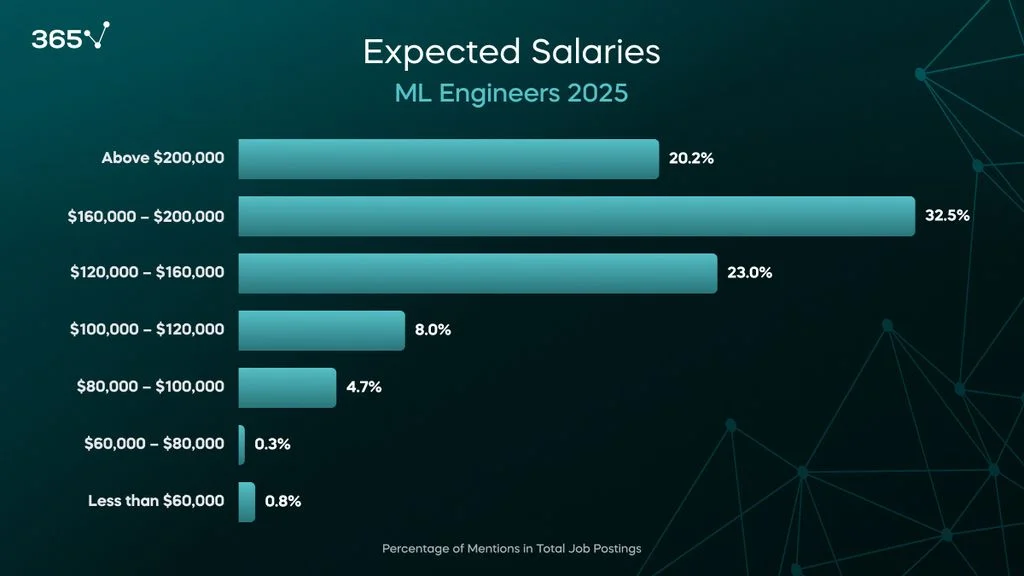
According to Glassdoor data from early 2025, the average machine learning engineer salary in the US is around \$155,000 annually. But, of course, machine learning salaries vary based on different experience levels:
0-1 Year: \$118,000
2-3 Years: \$134,000
4-6 Years: \$156,000
7-9 Years: \$169,000
10+ Years: \$191,000+
Machine learning engineers stand out in our 2025 job market research—they're the only position to see a decrease in average salary compared to 2024, according to Glassdoor. While the popular salary reporting site cited an average of \$166,000 in early 2024, that figure has dropped by approximately \$10,000 in 2025.
Our research tells a different story. We found that most machine learning engineer jobs (33%) offer salaries between \$160,000 and \$200,000. The second most common range is \$120,000 to \$160,000 at 23% of postings, while positions paying above \$200,000 make up about 20% of listings.
The apparent salary drop in Glassdoor's data likely doesn't reflect the true market reality. Glassdoor relies on anonymous, self-reported salary data from employees and job seekers, which can lead to reporting delays and potential sampling biases.
Our direct analysis of current job postings shows that ML engineering salaries remain strong, with most positions offering between \$160,000 and \$200,000, suggesting that Glassdoor's early 2025 figures may be understating the actual market rates.
Required Experience
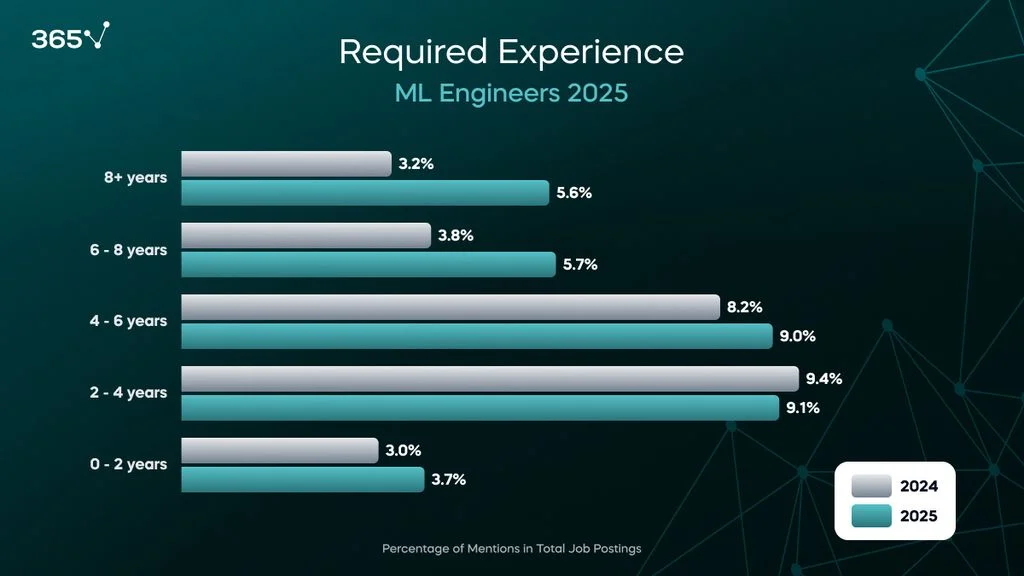
In 2025, most ML engineering roles target professionals with 2–6 years of experience, accounting for about 18% of job postings.
Senior ML engineers remain in high demand across the industry. But newcomers to the field may face challenges breaking in, as entry-level positions make up just 3% of current job postings.
This may indicate that many employers expect ML engineering to be a second stage in one's career journey, coming from roles like data analyst, data scientist, or software engineer.
Only a third of job listings, however, specify required years of experience. This means that what you can actually do—demonstrated through your skills and project portfolio—may be more important than how long you've been in the field.
Boost your portfolio with ready-to-build projects from 365 Data Science that you can complete and add to your portfolio today!
What is the Machine Learning Engineer Job Outlook in 2025?
So what's the verdict on ML engineering in 2025? Our research shows it's still one of tech's most promising careers. Here are the key trends we've identified:
- Salaries remain strong, with most positions offering between \$160,000 and \$200,000
- California leads with 29% of ML jobs, though New York is gaining ground with 17%
- Cloud platforms are essential, with AWS showing growing dominance over Azure
One trend stands out: companies are evolving beyond pure ML specialists. More and more, they’re seeking engineers who can handle the full technical stack, from model development to data pipeline management. The message is clear—versatility matters.
So, is machine learning engineering a good career? Yes, according to our findings.
While remote work opportunities have decreased significantly (dropping from 12% to 2% of positions), most companies now offer flexible hybrid arrangements. For those willing to relocate to tech hubs, the combination of challenging problems and competitive compensation makes ML engineering an attractive career path.
Keep in mind that this field demands continuous growth. The technologies and tools that matter today will evolve, so staying adaptable and committed to learning is key to long-term success.
Become a Machine Learning Engineer with 365 Data Science
At 365 Data Science, we have a wide range of in-depth courses that let you shape your own machine learning career path based on your goals and experience.
If you're just getting started, courses like Machine Learning in Python or The Machine Learning Process A-Z will walk you through the fundamentals step by step. When you're ready to go deeper, you can explore focused topics like Naïve Bayes, Support Vector Machines, Decision Trees, and K-Nearest Neighbors. Want to expand into deep learning? We've got courses on TensorFlow, Convolutional Neural Networks, and more.
There’s also a strong foundation in the math behind ML with Linear Algebra and Feature Selection, and hands-on, business-focused applications like Time Series Analysis, Customer Analytics, and more.
All our courses are taught by experienced instructors and come highly rated by thousands of learners. So whether you're looking to break into the field or level up your existing skills, you'll find what you need to stay competitive in the job market. Try them for free today!
We hope this machine learning engineer job outlook helped you understand what a machine learning engineer is and gave you a clearer idea of what to focus on in 2025. If you're ready to start learning, we’re here to help every step of the way.
FAQs

![AI Engineer Job Outlook 2025 [Research on 1,000 Job Postings]](https://365datascience.com/resources/blog/thumb@360_zap2iyp8btk-ai-engineer-job-market-thumb.webp)
![Data Scientist Job Outlook 2025 [Research on 1,000 Job Postings]](https://365datascience.com/resources/blog/thumb@360_9i9eyv5957g-data-scientist-job-market-research-2025.webp)
![The Most In-Demand Machine Learning Engineer Skills in 2024 [Research on 1,000 Job Postings]](https://365datascience.com/resources/blog/thumb@360_rtwxu4h3tr-1000-ml-engineer-job-postings-analysis-from-indeed-usa-thumb.webp)

